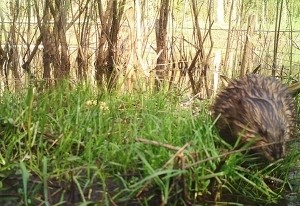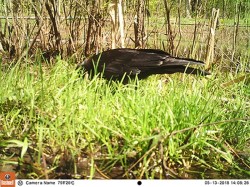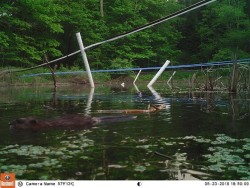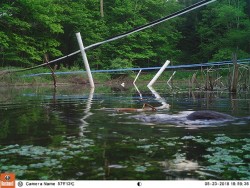At this organization we will not tolerate a bad word said about the legendary flatpicker Doc Watson. The man was an icon. And yet it can be said – uncomfortably and with downcast eyes, hat in hand while our toes scratch patterns in the gravel – that his tune “Muskrat” does seem...how would one put it?...just a tad ecologically suspect.
It’s not just Doc, or course. Somehow these wee rodents are perpetually misunderstood and misidentified. We had someone write here once asking how to get rid of the muskrat that lived under the chicken coop. We explained it was a woodchuck. Another time someone asked about the muskrats living in the compost pile. We told them they had actual rats. Sometimes the poor things don’t even get credit for being muskrats when people do see them. There’s a farm pond with a muskrat in it at the base of the hill near the sugarhouse, and on more than one occasion passersby have told us about the baby beaver living in the pond.
In a lot of cases it’s possible to diagnose a misdiagnosis without visual evidence. But in the case of Doc’s song, we’re at a loss. Take the first verse:
Muskrat, oh muskrat, what makes you smell so bad?
That seems like skunk, of course. But
Layin' around the farmer's house eatin' up all he had...
makes us think teenaged boy.
Runnin' around all over the field eatin' up all my corn...
is clearly raccoon. But
He’s even been in the onion patch.
That one gave us pause. Muskrats are fond of tubers, with a special fondness for white cattail roots, so while it seems unlikely they’d be raiding an onion patch, we couldn’t rule it out.
And so we took the game cameras down to the pond, put an onion and a pile of corn in front of it, and sought photographic evidence.
On day one the muskrat showed up but stayed just to the edge of the frame, and then just out of focus. He didn’t touch the onion or the corn. Two days later, a crow came and ate the corn.
At that point we decided to move the bait to a more conspicuous spot. We found a food bed that the muskrat was a-using and put the corn and the onion there. One hour later a crow came and ate all the corn. The onion sat untouched for five days.
It seemed like solid proof that muskrats don’t care for corn or onions – in fact once the onion was set on the foodbed, the muskrat stopped using it. But as a control we set up the camera on the north bank of the pond, where there were cattails and sedges and arrowhead – foods muskrats actually like to eat – just to be sure the muskrat was still in the area. We set the camera up at 7 a.m., and got our first shot of the muskrat at 6 p.m. We captured images of him working the reeds during each of the subsequent nine hours.










